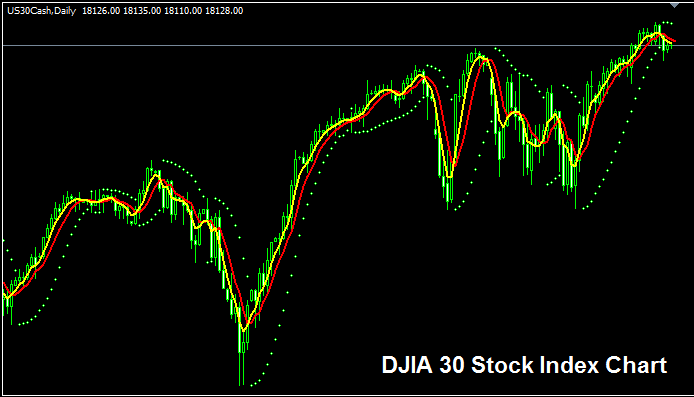Dow Jones Industry Average or Dow 30 - Wall Street 30 Stock Index
Dow Jones Industry Average or Dow 30 is a market indices that keeps track of 30 of the largest stocks in the US. The stocks & shares that are used in calculating these components are selected from 30 largest companies in the US.
The Dow Jones is the most liked and most followed Stock Indexes worldwide. The Dow Jones Industry Average stock index traditionally kept track of the performance of Industrial stocks but that has changed to include also stocks from other economic sectors of the overall economy. Main criteria being the shares/stocks chosen are from the largest US companies.
The Dow Jones is more volatile than most of the other Top Indices, The Dow Jones though will over the long term trend upward it'll have more price pull backs and more consolidations than other Indices. Traders might prefer to trade other indexes other than Dow Jones Industry Average if they are more used to trading more stellar & robust trends found in the other top stock indices.

The DowJones30 Stock Index Chart
The DowJones30 Index chart is displayed & illustrated above. On the above illustration this financial instrument is named USA 30CASH. As a trader you want to find a broker who offers DowJones 30 Index chart so that as you as a trader can begin to trade it. Example displayed above is of DowJones30 Index on the MT4 Forex Platform Software.
Other Data about DowJones30 Index
Official Symbol - DJI
The 30 component stocks which makes up DowJones30 Index are chosen from the top America companies. The calculation of this index is however different compared to other Index: the price constituent of the 30 stocks is sub-divided by a common divisor so as to come up with this stock index. This makes this index more volatile than others.
Strategy of Trading DowJones30 Index
DowJones30 Stock Index approach of calculation make Dow 30 index more volatile & therefore there are much wider swings in price movement of this index. Although this index generally move upwards over long-term because the US economy also indicates strong growth & is also the biggest economy in the globe.
As a trader wanting to trade this index, be prepared for wider price swing & a little more volatility.
As a index trader you want to be biased and keep on buying as the index heads and moves upward. When the US economy is performing and doing good (most times it's doing good) this upward trend is more than likely to be the one ruling. A good index trading strategy would be to buy dips.
During Economic SlowDown & Recession
During economic slow-down and recession times, firms begin to report slower revenues and earnings, slower profits & lowers growth projection. It's because of this reason that traders start & begin to sell shares of corporations which are posting & recording lower profits & hence the Index tracking these specified stocks will also begin to move downward.
Hence, during these times, market trends are a lot more likely to be heading downward and you as a trader should also adjust your strategy accordingly to suit the ruling downwards trends of the index which you're trading.
Contracts and Specifications
Margin Required for 1 Lot - $150
Value per Pips - $ 0.5
NB: Even though general and overall trend is generally moves upward, as a trader you've got to consider and factor in the daily market volatility, on some of the days the Index may oscillate or even retrace & retracement, market retracement/correction move might also be a large one at times & therefore you as a trader you need to time your entry precisely using this strategy: Index strategy & at the same time use the suitable and appropriate & appropriate and proper money management principles and guidelines just in case there's more unexpected volatility in the market. About equity management rules and guidelines in stock indices topics: What is index equity management & money management strategies.
More Guides & Tutorials:
- Calculate Value/Size of 1 Pips of S&PASX200 Stock Index
- MT4 Online XAU USD MetaTrader 4 Brokers
- How to Start Gold for Beginner Traders Guide Tutorial
- Learn XAUUSD Lessons and Tutorials and Gold Training Course Training Course Tutorials
- How to Use MT5 T3 MA Indicator in MetaTrader 5 Software
- How to Place Zigzag Indicator in FX Chart on MT4 Software
- Balance of Power BOP MetaTrader 4 Technical Indicator Trading Analysis
- Ichimoku Forex Trade Buy Sell Signal
- GBPHKD Opening Time and GBPHKD Closing Time


